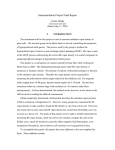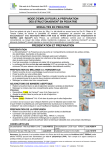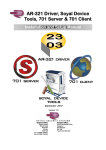Download “Series 3” INSTALLATION MANUAL
Transcript
PAC1 Single Door Access Controller “Series 3” INSTALLATION MANUAL TABLE OF CONTENTS PAGE Introduction .....................................................................1 Features ...........................................................................1 Changes From Series 2..................................................2 Specifications .................................................................2 Terminal Descriptions ....................................................3 Programmable Features Description ...........................5 Automatic Relock Function..........................................5 Door Open Too Long ...................................................5 Door Forced Open .......................................................5 One Minute Lockout ....................................................6 High Security Mode .....................................................6 Installation .......................................................................7 VR43 (and VR62) Keypad Wiring................................7 PRE Keypad Wiring .....................................................8 PSE Keypad Wiring .....................................................8 PRO2410 Proximity Reader Wiring .............................9 D.C. Lock ...................................................................10 A.C. Lock ...................................................................10 Egress Input Switch ...................................................10 Door Input Switch ......................................................10 Programming ................................................................11 Keypad Responses ...................................................11 Using a Presco™ Keypad without E Key .................12 i Reset All Memories Codes ........................................12 Basic Set Up Sequence ............................................13 Automatic Relock. Memory 80 .................................14 EGRESS Switch Type. Memory 81 ..........................14 ELC Relay Type. Memory 82 ...................................15 ELC Operating Time. Memory 83.............................15 Door Input Enable. Memory 84 ................................15 Door Open Too Long Timer. Memory 85 .................16 Door Forced Open Detection. Memory 86 ...............16 One Minute Lockout. Memory 87 .............................16 High Security Mode. Memory 88 ..............................17 High Security Mode Timing. Memory 89 ..................17 Momentary Codes Turn Off Toggle. Memory 91......18 Series 2 Compatibility. Memory 99...........................18 Installation Programming Summary...........................19 Warranty ........................................................................20 ii INTRODUCTION The Presco™ Digital Door Access Decoder utilises the latest microprocessor technology to operate most electric door locking devices on the market. The decoder together with an encoder (Presco™ keypad (PRE or PSE) or a Presco™ Interface Module (PIM) with a Clock & Data (magnetic card format) or Wiegand output reader) offers access control to restricted areas. FEATURES Split system for maximum security (Encoder & Decoder). Door Forced Open detection. Door Open Too Long (DOTL) function. EGRESS function. Automatic door relock function. Easy on site programming using any Presco™ keypad. 600 client programmable users. Heavy Duty 5 Amp. relay contacts for lock control. Can operate Fail Safe or Fail Secure electronic locking mechanisms. 1 Amp Normally Open DOTL Alarm relay output. 10 year non volatile EEPROM memory. 36 month (3 year) manufacturer’s warranty. Designed and manufactured in Australia. 1 CHANGES FROM SERIES 2 1. The PAC1 now supports 600 user codes. 2. Egress input can now be programmed as edge triggered (momentary only) so that keeping the Egress input triggered will not keep the door open permanently. 3. User code programming has been simplified (refer to the supplied User Code Programming Manual). 4. Bulk adding of users is now supported. 5. Can be set to Series 2 compatible mode for use with existing PACDL installations. 6. Two Codes Mode is now called High Security Mode. SPECIFICATIONS Voltage: (absolute min-max)1 11-30 Volts D.C. 14-28 Volts A.C. Current: 120 mA D.C. max. 160 mA A.C. max. ELC contacts: 30 Volt, 5 Amp A.C./D.C. SPST. (Electric Latch Control) Programmable as N.O. or N.C. DOTL contacts: 30 Volt, 1 Amp A.C./D.C. SPST. (Door Open Too Long) Operating Temperature: 0C to 70C. Size: 104mm x 72mm x 27mm. Weight: 150gms. 1 Operating the unit at a voltage outside the specified range may cause intermittent operation or result in damage to the unit. 2 TERMINAL DESCRIPTIONS GND Negative input (or ground) from the power supply. AC-DC A.C. 16 - 24 Volt or D.C. 12 - 24 Volt positive input from the power supply. DTA Data line to encoder (white wire on keypads). LED Output to drive a LED to indicate door unlocked. ELC (Electric Latch Control) 5 Amp relay output. The ELC relay is used to control the door locking/release mechanism. The relay can be programmed as either Normally Open for fail secure applications (power applied to open door) or Normally Closed for fail safe applications (power applied to lock door). DOOR This input requires a normally closed switch connected to ground, typically a reed switch attached to the door. The DOOR input is used by the PAC1 to monitor when the door is physically open (not unlocked). In order to use this input it must first be enabled (via memory 84, refer to page 15) and a normally closed (when the door is closed) door switch (or monitored lock contacts) must be connected between DOOR and GND. The DOOR input is used to detect when the door has been opened for use by the door forced open, Door Open Too Long and automatic relock functions. DOTL (Door Open Too Long) 1 Amp Normally Open relay output, operates when a DOTL or Door Forced Open alarm condition occurs. 3 EGRS The EGRESS input can take either a normally open or normally closed switch between EGRESS and GND. When this input is activated the ELC relay will come on and remain on for the time that the EGRESS input is on. Once the EGRESS input is released the timing set for ELC will begin. The other selected features of the PAC1 (DOTL, Door Forced Open & Automatic Relock) will also become active at this time. Therefore the EGRESS input can be used to hold the door open indefinitely with the use of a toggle switch, or with the use of a momentary type switch it can be used to release the door for a set time in exactly the same way that a momentary user code does. DLOG Data input/output for connection to an optional PELSA1 or PEL1 event logger or a PACDL when in Series 2 Compatible mode. 4 PROGRAMMABLE FEATURES DESCRIPTION Automatic Relock Function When the DOOR input is used then the Automatic Relock function can be used. This feature turns the ELC relay off 1 second after the door is opened (not unlocked) when a momentary code or the EGRESS input has been used (no matter how long the time for the ELC relay operation has been set for in memory 83). The purpose of this feature is to stop people following someone through the door by ensuring that the door locks once it closes. Door Open Too Long The DOTL timer is used to warn if the door has been held open for too long after a valid access (either via a code or EGRESS). When the door has been opened a countdown timer is started (the time set in memory 85, refer to page 16). If the door has not closed again by the time this counter expires then the DOTL output will activate (contacts will close) and will remain active until the door is closed. Note that if a value of 0 has been set for the DOTL time then the door is allowed to remain open indefinitely. Door Forced Open A door forced open condition is defined by the situation where the door has been opened but a code or EGRESS has not been used to gain access. When this condition occurs the DOTL output will activate (contacts will close) and will remain active for 30 seconds or until the door is closed again (whichever is the longer time). Note that the Door Forced Open feature must be disabled (set in memory 86, refer to page 16) if a free (unmonitored) inside door handle is used instead of an EGRESS button. When this feature is disabled the Door Open Too Long timer will be started when the PAC1 detects the door has been opened. 5 One Minute Lockout To increase security the PAC1 can be set to lock out all codes for a period of 1 minute after 5 incorrect codes have been tried (set in memory 87, refer to page 16). Note that this feature should not be enabled if access must be guaranteed in an emergency situation. High Security Mode The PAC1 can be set up to operate in one of the four modes described below. Normal Mode (High Security Mode Disable) Any one of the programmed user codes will operate the ELC relay. Any Two User Codes Any two of the programmed user codes must be used together to operate the ELC relay. Code 000 or 001 and any other user code The user code stored in memory 000 or 001 used together with any other valid user code will operate the ELC relay. Sequential Memory User Codes Two user codes in sequential memory locations must be used together to operate the ELC relay. The paired code locations start with an even number, e.g. 000 & 001, 056 & 057, 138 & 139, etc. IMPORTANT NOTE: When the PAC1 is set up to use any of the high security modes above, the ELC relay will only operate in Momentary (timed) Mode even if the codes are programmed as Toggle codes. 6 INSTALLATION Read all instructions carefully before installing, programming and using the system. It is vital that all power be disconnected during wiring. To maximise security ensure that the decoder and encoder components are separated and that the decoder is inaccessible to persons outside the restricted area. The decoder should be installed indoors and in a dry secure place. The maximum distance of separation between the decoder and encoder is 1 kilometre. The wiring diagrams for installation are on the following pages. VR43 (AND VR62) KEYPAD WIRING 7 PRE KEYPAD WIRING PSE KEYPAD WIRING 8 PRO2410 PROX READER WIRING Note that the Green, Yellow, Violet, Brown and Drain wires are not connected when the PRO2410 is used with a PAC1 decoder. * Use a 100mA inline fuse to protect the power supply from short circuiting if the PRO2410 wires are tampered with. This is particularly important when using fail safe (power to lock) locking mechanisms such as Magnetic Locks. 9 D.C. LOCK A.C. LOCK * Use 1N4004 diode only when using a Door Strike, not a Magnetic Lock or Drop Bolt. VOLTAGE FREE CONTACT OUTPUT EGRESS SWITCH INPUT DOOR SWITCH INPUT 10 PROGRAMMING The most common method of programming is using a Presco™ keypad connected to DTA. Alternatively a PELSA1, PEL1 or PIM connected to DLOG can be used. To enable programming with a keypad the PAC1 must first be put into program mode. This is accomplished by pressing the program button located in the bottom centre of the PAC1 below the “PUSH TO PROGRAM” text. When the program mode is entered the LED above the program button in the PAC1 will light up. Pressing the program button again will take the PAC1 out of program mode. The PAC1 will remain in program mode for a period of 5 minutes after the button has been pressed. Each time the keypad is used to successfully enter information the 5 minute timeout period is restarted. The PAC1 can be forced to exit program mode from the keypad by simply entering #99E. When the PAC1 is in program mode the green LED on an attached PRE, VR43 or VR62 keypad will flash at a rate of once per second (provided it has been wired as shown in the wiring diagrams on pages 7 & 8). Programming of installation options via a keypad use the following sequence:* “2 digit memory number” “memory value” E KEYPAD RESPONSES warble (ringing) = successful programming operation finished. long beep = unsuccessful operation. 11 NOTE all keys in a sequence (up to and including the e) must be pressed within 10 seconds of each other. If incorrect keys are pressed wait 10 seconds and then enter the sequence again. USING A PRESCO™ KEYPAD WITHOUT E KEY When using a keypad that does not have an E key (VR43, VR62 or PSE), simply use the # key instead of E at the end of the sequence, all other steps remain the same. CLEAR ALL USER CODES. All the user codes memories (000 to 399) can be cleared by the use of the following sequence. #8765E RESET TO FACTORY DEFAULTS. The PAC1 can be reset to factory defaults by the use of the following sequence. WARNING: Using this code will delete all user codes, the management code and reset memories 80 to 99 back to their factory default settings. To reset the PAC1 to factory defaults… #87654321E 12 BASIC SETUP SEQUENCE 1/ Enable/Disable SERIES 2 COMPATIBILITY (Currently disabled). [Memory 99, page 18] 2/ Select ELC RELAY TYPE (Currently N.O.). [Memory 82, page 15] 3/ Select EGRESS switch type (Currently N.O. level triggered). [Memory 81, page 14] 4/ Set ELC OPERATE TIME (Currently 10 seconds). [Memory 83, page 15] 5/ Enable/Disable DOOR INPUT (Currently disabled). [Memory 84, page 15] 6/ Set Door Open Too Long time (Currently 60 seconds). [Memory 85, page 16] 7/ Enable/Disable DOOR FORCED OPEN DETECTION (Currently enabled). [Memory 86, page 16] 8/ Enable/Disable AUTOMATIC RELOCK (Currently enabled). [Memory 80, page 14] 9/ Enable/Disable 1 MINUTE LOCKOUT (Currently disabled). [Memory 87, page 16] 10/ Enable/Disable HIGH SECURITY MODE (Currently disabled). [Memory 88, page 17] 11/ Set HIGH SECURITY MODE TIMING, if enabled in step 9 above (Currently 60 seconds). [Memory 89, page 17] 12/ Enable/Disable MOMENTARY CODES TURN OFF TOGGLE (Currently disabled). [Memory 91, page 18] 13 Automatic Relock Memory 80 (Factory Default: Enabled) Disabling the Automatic Relock function prevents the ELC relay output from deactivating 1 second after the door is opened. This function is only valid when the DOOR input is being used. To disable the Automatic Relock function… *800E To enable the Automatic Relock function… *801E EGRESS Switch Type Memory 81 (Factory Default: Normally Open Level Triggered) Either a normally open or normally closed EGRESS switch setting may be selected. To set the EGRESS switch input to N.O. level triggered… *810E To set the EGRESS switch input to N.C. level triggered… *811E To set the EGRESS switch input to N.O. edge triggered… *812E To set the EGRESS switch input to N.C. edge triggered… *813E When level triggered is selected the door will remain unlocked whilst the egress is activated (button held on), once the input is released normal ELC the timing will start. When edge triggered is selected the door will unlock only for the time set for ELC regardless of how long the egress input is active for (button held on). 14 ELC Relay Type Memory 82 (Factory Default: Normally Open) The electronic latch control (ELC) relay can be set to operate as either Normally Open (N.O.) for fail secure or Normally Closed (N.C.) for fail safe. To set the ELC relay type to normally open… *820E To set the ELC relay type to normally closed… *821E ELC Operating Time Memory 83 (Factory Default: 10 seconds) The electronic latch control (ELC) relay can be set to operate for 1 second to 255 seconds in 1 second increments. To change the ELC operate time… * 8 3 “the time in seconds” E Door Input Enable Memory 84 (Factory Default: Disabled) If the “Door Open Too Long” and “Door Forced Open” functions are required then the input from the door switch must be enabled. Note: enable only if your door has a reed switch or the latch is monitored. To disable the door input… *840E To enable the door input… *841E 15 Door Open Too Long Timer Memory 85 (Factory Default: 60 seconds) The time allowed for the door to be open before a DOTL alarm is generated can be set from 1 to 9999 seconds. A time of zero seconds will disable this function. To change the DOTL time… * 8 5 “the time in seconds” E Note that time of 0 seconds will disable the DOTL function. Door Forced Open Detection Memory 86 (Factory Default: Enabled) Disabling the Door Forced Open function prevents the DOTL output from activating (contacts closing) when the door is opened without a valid code or EGRESS switch having been used. To disable Door Forced Open Detection… *860E To enable Door Forced Open Detection… *861E One Minute Lockout Memory 87 (Factory Default: Disabled) Enabling the 1 minute lockout function means that the system will not accept any codes for 1 minute after 5 successive invalid codes have been entered. To disable the one minute lockout… *870E To enable the one minute lockout… *871E 16 High Security Mode Memory 88 (Factory Default: Normal Mode) The high security mode memory is used to select the mode that the PAC1 operates in. The value programmed into memory 88 selects either Normal Mode, Any Two User Codes, Code 000 or 001 and any other user code or Sequential Memory User Codes. For a description of each of these operating modes refer to the High Security Mode section on page 6. To select Normal Mode (High Security Mode Disabled)… *880E To select Any Two User Codes mode… *881E To select Code 000 or 001 and any other user code mode… *882E To select Sequential Memory User Codes mode… *883E IMPORTANT NOTE: When the PAC1 is set up to use any of the high security modes above (not Normal Mode) the ELC relay will only operate in Momentary (timed) Mode even if the codes are programmed as Toggle codes. High Security Mode Timing Memory 89 (Factory Default: 60 seconds) If the PAC1 is set up to operate in any of the High Security Modes above, then the two codes must be entered within the time specified in memory 88. This time may be set between 1 and 255 seconds. To set the time allowed between two codes… * 8 9 “the time in seconds” E 17 Momentary Codes Turn Off Toggle Memory 91 (Factory Default: Disabled) When a toggle (latching) code has been used to unlock the door and keep it unlocked, a toggle code has to be used again to relock it. If this memory is enabled then any programmed user code (momentary or toggle) can be used to relock the door. To disable momentary codes from turning off toggle… *910E To Enable momentary codes to turn off toggle… *911E Series 2 Compatibility Memory 99 (Factory Default: Disabled) Enabling this memory forces the PAC1 Series 3 to become a Series 2 version for compatibility when used with a PACDL. When this memory is enabled the number of user codes is reduced to 400, the Egress Switch Type (mem 81) cannot be Edge Triggered and Momentary Code cannot turn off toggle (mem 91). To disable Series 2 compatibility… *990E To enable Series 2 compatibility… *991E 18 INSTALLATION PROGRAMMING SUMMARY Enable/Disable Automatic Relock. (default = enabled) * 8 0 x E. x = 0 for disabled, x = 1 for enabled. Select EGRESS switch type. (default = N.O.) * 8 1 x E. x = 0 for N.O. level, x = 1 for N.C. level, x = 2 for N.O. edge, x = 3 for N.C. edge. Select ELC relay type. (default = N.O.) * 8 2 x E. x = 0 for N.O. (fail secure), x = 1 for N.C. (fail safe). Set ELC operating time. (default = 10 seconds) * 8 3 xxx E. xxx = 1 to 255 (seconds). Enable/Disable DOOR input. (default = disabled) * 8 4 x E. x = 0 for disabled, x = 1 for enabled. Set DOTL timer. * 8 5 xxxx E. (default = 60 seconds) xxxx = 0 to 9999 (seconds). Enable/Disable Door Forced detection. (default = enabled) * 8 6 x E. x = 0 for disabled, x = 1 for enabled. Enable/Disable 1 minute lockout. (default = disabled) * 8 7 x E. x = 0 for disabled, x = 1 for enabled. Select High Security Mode. (default = Normal Mode) * 8 8 x E. x = 0 for Normal Mode, x = 1 for Any Two User Codes, x = 2 for Code 000 or 001 and any other, x = 3 for Sequentially Stored User Codes. Set High Security Mode timing. (default = 60 seconds) * 8 9 xxx E. xxx = 1 to 255 (seconds). 19 Enable/Disable Momentary Codes Turn Off Toggle. (default = disabled) * 9 1 x E. x = 0 for disabled, x = 1 for enabled. Enable/Disable Series 2 compatibility. (default = disabled) * 9 9 x E. x = 0 for disabled, x = 1 for enabled. Exit Program Mode. # 9 9 E. WARRANTY The manufacturer will replace or repair this product if proven to be faulty (excluding accidental or malicious damage) under the 36 month warranty offered from the date of purchase. As NIDAC Security Pty. Ltd. or its agents do not perform the final installation, inspection or training in the use of this product, they cannot be held liable for injury, loss or damage directly or consequentially arising from the use or misuse of this product. The software design of the NIDAC Presco™ is protected internationally. Design improvement and specification changes are subject to change without notice. All designs are copyright protected. 20 ACCESSORIES AND OTHER MODELS PRE VR43 Indoor keypad for Presco™ decoder. 4x3 Surface Mount vandal and weather resistant keypad. VR62 6x2 Surface Mount architrave style vandal and weather resistant keypad. PSE 4x3 Semi Flush Mount vandal and weather resistant keypad for Presco™ decoders. PRO2410 Proximity card reader for PAC1, PAC2 or Wiegand input controller. PIM Interface Module for Dallas iButton™, Clock & Data (Magnetic Card) or Wiegand readers. PAC2 2 Door Access Controller with 800 users. 100% Designed and Manufactured by: NIDAC SECURITY PTY. LTD. 2 CROMWELL STREET BURWOOD, VICTORIA AUSTRALIA 3125 www.nidac.com PAC1 Series 3 Installation Manual.docx Tel: (03) 9808 6244 Fax: (03) 9808 9335 [email protected] Revision 1.0




































